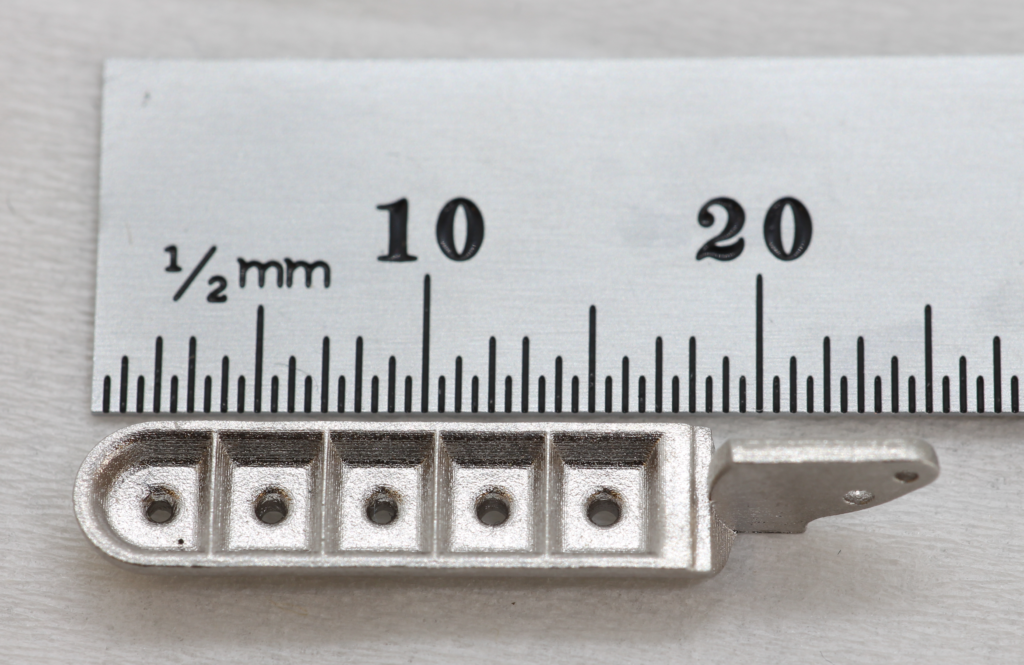Holo, which uses photopolymer slurry and stereolithography (Slurry SLA, as I am dubbing it) to make precise metal components, has announced the completion of a Series B round of funding. In the Series B, Holo most likely raised more than $1, but the exact number has not been disclosed. Investors included Lam Capital, Atreides Management, and Prelude Ventures, along with previous backers Tao Capital Advisors and Lightspeed Venture Partners.
“Traditional manufacturing approaches, such as Swiss CNC, molding and casting are either too costly for volume production or cannot produce complex parts with such fine features. PureForm MicroAM enables our customers to access parts at a lower cost and produce geometries that cannot be made any other way,” said Hal Zarem, Holo’s CEO.
We previously profiled Holo’s wish to make millions of copper parts for industry, initially in house. Now, the firm, which is an Autodesk spinout, has opened up its PureForm 3D printing service for stainless steel, in addition to copper. With the new funds, the company wants to expand its facilities and move into more materials and applications. The firm is eying jewelry, dental, medical devices as well as electronic components. They also want to double the size of the company and offer even more materials.
“We’ve been blown away by the resolution and surface quality of the parts Holo can produce and are excited to explore the direct metal printing of jewelry with them. Leveraging the design freedom of additive and the fine features of PureForm will allow us to create truly unique, custom pieces for our clients that couldn’t be made using other manufacturing processes,” noted Simon Evans, senior manager of Diamond Center Wales.
Together with Lithoz, Admatec, MetShape, and Incus, Holo is adding a new quiver to 3D printing’s bow. Combining the precision of SLA and digital light processing (DLP) with sintering can lead to new business cases and new parts that are possible with 3D printing.
With a focus on volume, Holo really has quite the value proposition. We must not forget that companies such as 3D Micro Print have been doing this kind of thing for a decade or more using other 3D printing technology. With similar sizes and volumes, what Holo is doing is not really new, exactly. But, given the investment by other industries in LCD, DLP, and other light sources, Slurry SLA processes can piggyback on these technological developments to increase their capabilities. SLA machines typically work well and Admatec, Lithoz similar firms have shown that production is viable with the technology.
What is unique about Holo’s offering is that it is producing a high-volume solution that is more scaled to manufacturing and more production-line based than current solutions in Slurry SLA. Potentially, the firm could sell this line to services and end users, as well. This could really open up this technology for much larger volumes.
Typically, so far, there have been a number of known, but not well publicized micro-scale 3D printing components selling in production runs of thousands and tens of thousands. This has been ongoing for many years now. With new attention and significant investment, Slurry SLA could very well be the technology that makes the micro-scale much more accessible.
“We are excited to continue to offer new capabilities to our customers, enabling us to support a host of new MicroAM applications from surgical equipment and dental, to micro-electronics, micro-robotics, consumer electronics and jewelry,” Arian Aghababaie, co-founder of the Autodesk spinout said.
“In a short period of time, Holo has developed the highest quality and most cost effective AM technology for volume production,” contributed Mark Cupta, managing partner at Prelude Ventures.
Above, the company showcases copper micro inductor arrays, as well as jewelry pieces, that could very well be very interesting markets for Holo. The steel dental abutment is a potentially huge market, as well, with the right pricing and approvals. Holo could enable manufacturing in many areas with one and the same basic technology set up and many different materials.
This could make for an exciting business case from the viewpoint of an investor in a potentially expanding market for myriad new applications and parts. I still think that Holo’s initial focus on copper was very exciting. This is a difficult and costly technology to do in many other processes, such as powder bed fusion. But, with an expanding materials portfolio, the company could yet find not one but many winning applications in high-volume metal printing.
